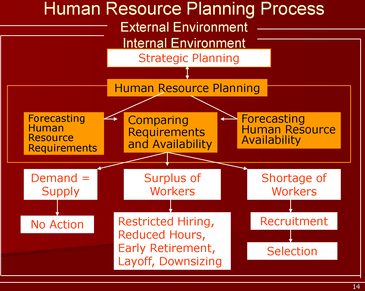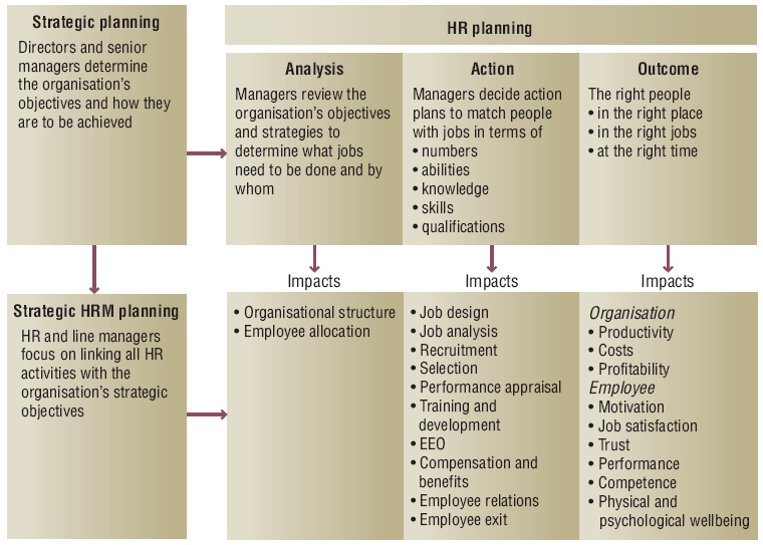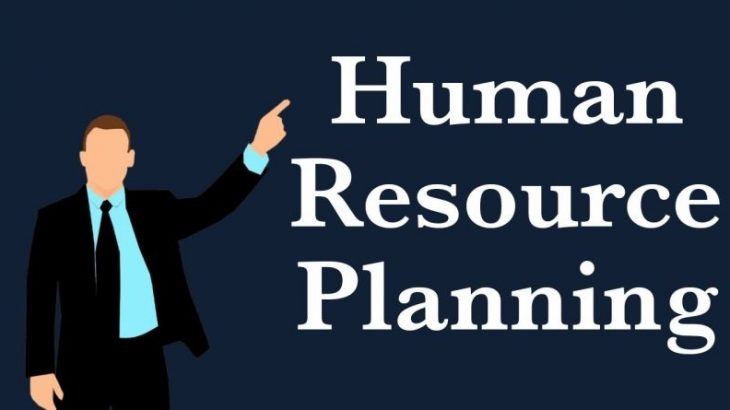According to Mondy et (1996) Human Resource Planning is a systematic analysis of HR needs in order to ensure that correct number of employees with the necessary skills are available when they are required.

To understand the Human Resource Planning First, we will see what is Planning? and why is it needed?
What is planning?
Plans are methods for achieving a desired result. Goals or objectives are specific results you want to achieve. Planning is thus “the process of establishing objectives and courses of action prior to taking action.”
What is planning concerned with?
Planning provides a sense of purpose and direction. It is a comprehensive framework for making decisions in advance. It also facilitates the organizing, leading, and controlling functions of management.
Planning: allows you to make your decisions ahead of time, it helps you to anticipate the consequences of various courses of action, it provides direction and a sense of purpose, it provides a unifying framework against which to measure decisions, and thus helps you avoid piecemeal decision making. Planning also helps identify potential opportunities and threats, and facilitates control. It is concerned with the end (what is to be done) as well as with means (how it is to be done).
Human Resource Planning (HRP) may be defined as strategy for acquisition, utilization, improvement and preservation of the human resources of an enterprise. The objective is to provide right personnel for the right work and optimum utilization of the existing human resources. HRP exists as a part of the planning process of business. This is the activity of the management which is aimed at coordinating requirements for and the availability of different types of employers. The major activities of HRP include: forecasting (future requirements), inventorying (present strength), anticipating (comparison of present and future requirements) and planning (necessary program to meet future requirements).
Human Resource Planning involves gathering of information, making objectives, and making decisions to enable the organization achieve its objectives and goals. Surprisingly, this aspect of HR is one of the most neglected in the HRM field. When Human Resource Planning is applied properly in the field of Human Resource Management, it would assist to address the following questions:
- How many number of staff does the Organization have?
- What type of employees as far as skills and abilities does the organization have?
- How should the Organization best utilize the available human resources?
- How can the organization keep its employees?
Human resource planning was defined by various authorities on this subject as under:
“It is almost as difficult to keep a first class person in a fourth class job, as it is to keep a fourth class person in a first class job.”
— Paul H. Dunn
Definitions:
Human resources planning is the process by which management ensures that it has the right personnel, who are capable of completing those tasks that help the organization reach its objectives. It involves the forecasting of human resources needs and the projected matching of individuals with expected vacancies. —–International Labour Organization
According to Coleman, “Manpower planning is the process of determining manpower requirements and the means for meeting those requirements in order to carry out the integrated plan of the organisation”.
According to Jeisler, “Manpower planning is the process including forecasting, developing and controlling— by which a firm ensures, it has the right number of people and the right kind of people and at the right places at the right time doing things for which they are economically most useful”
According to Dale S. Beach, “Human resource planning is a process of determining and assuring that the organisation will have an adequate number of qualified persons, available at the proper times, performing jobs which meet the needs of the enterprise and which provide satisfaction for the individuals involved.”
According to Wickstron, “Human resource planning consists of a series of activities viz.: Forecasting future manpower requirement either in term of mathematical projection of trends in the economic environment and development in industry or in term of judgmental estimates based upon the specific future plans of a company.
- Making an inventory of present manpower resources and assessing the extent to which these resources are employed optimally.
- Anticipating manpower problems by projecting present resources into the future and comparing them with the forecast of requirements to determine their adequacy, both quantitatively and qualitatively; and
- Planning the necessary programs of recruitment, selection, training, development, transfer, promotion,
- motivation and compensation to ensure that future manpower requirements are properly met.
Hiring the right kind of people was cited as the most important challenge by 98 per cent of HR and business leaders in a survey. The second most-cited concern was retaining this talent, backed by 93 per cent of respondents.
Facts [+]
48% of Indian employers struggle to find the right candidate
June 2012,BANGALORE: The battle for the right candidate continues to rage as 48% of Indian employers struggle to find the right candidate for the job. A study on Talent Shortage by staffing firm Manpower Group shows that although down by 19% from last year, India’s hunt for suitable employees is high compared to global average of 34%.
The profiles on demand have also altered since same period last year. While it was difficult to hunt for R&D, sales manager and IT staff last year, this year the positions are for IT staff, marketing/public relations/communication staff and engineers. Personal assistants, call centre operators, researchers are also hard to find this year. Professions like labourers, doctors that had made it to the list have been struck off this time.
Lack of available candidates, technical competencies amongst those present, refusal to move to another location, poor image of the occupation, weak soft skills and demand for a higher salary have been key reasons in Asia Pacific for the posts to remain vacant.
Human resource planning Process

Problems in HRP Process
The main problems in the process of HRP are as follows:
a) Inaccuracy: Human Resource Planning is entirely dependent on the HR forecasting and supply, which cannot be a cent per cent accurate process.
b) Employee resistance: Employees and their unions feel that by Human Resource Planning, their workload increases so they resist the process.
c) Uncertainties: Labour absenteeism, labour turnover, seasonal employment, technological changes and market fluctuations are the uncertainties which Human Resource Planning process might have to face.
d) Inefficient information system: In Indian industries, HRIS is not much strong. In the absence of reliable data it is not possible to develop effective Human Resource Planning.
e) Time and expense: Human Resource Planning is time consuming and expensive exercise, so industries avoid.
Facts [+]
According to a recent study on workforce engagement, nearly one-third of the U.S. workforce fits the category of “unengaged.” Unengaged employees perform their jobs in ways that do not contribute to organizational success, performance, and profitability. The productivity loss of unengaged workers equals nearly $300 billion a year.





